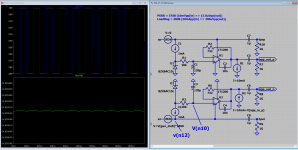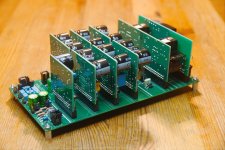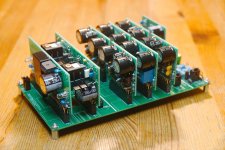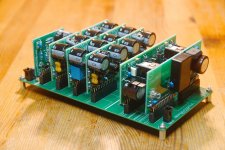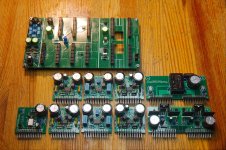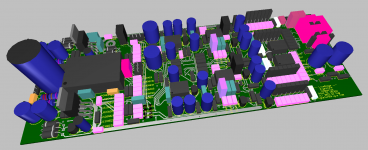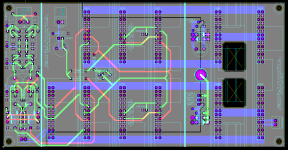Yes, a set of boards per channel, creating complete isolation (no ground), and thus 2 sets of +-15V regulators. P.s. the regulator chip is a LT1206 video amp http://cds.linear.com/docs/en/datasheet/1206fb.pdf
Line regulation 57dB and load regulation 40dB at 100kHz
And the reference? I do not know, why? (you ask, do I not know). When I add 10Vpp square waves of 50Hz to the line (where the reference is taken from), the simulation only shows 7.97uVpp triangular ripple (that is -120dB), now take into consideration that this thing is powered by a stabilized supply (the RAW supply is an isolated DC/DC-converter) and the actual reference PSRR is ... your guess.
And the reference? I do not know, why? (you ask, do I not know). When I add 10Vpp square waves of 50Hz to the line (where the reference is taken from), the simulation only shows 7.97uVpp triangular ripple (that is -120dB), now take into consideration that this thing is powered by a stabilized supply (the RAW supply is an isolated DC/DC-converter) and the actual reference PSRR is ... your guess.
Last edited:
Hi,
I assumed the topology You showed ... a Buffer or Amplifier for a Reference voltage.
As such the PSRR of the reference plays the major role, doesn't it PapaBear? 😉
jauu
Calvin
I assumed the topology You showed ... a Buffer or Amplifier for a Reference voltage.
As such the PSRR of the reference plays the major role, doesn't it PapaBear? 😉
jauu
Calvin
Progress report, this is what you (all) have been waiting for. The pictures show (not the Zion) all components (except the base board containing the input stage) needed to assemble the (a) Zion 🙂
The board shown is a (mono) linestage for my amplifier, the components shown are:
Base board
Clipper
Input stage
Servo's
Output stage
Linear PSU
SMPS
All tested and ok'ed 🙂
Next the Zion base board.
The board shown is a (mono) linestage for my amplifier, the components shown are:
Base board
Clipper
Input stage
Servo's
Output stage
Linear PSU
SMPS
All tested and ok'ed 🙂
Next the Zion base board.
Attachments
Never will do something like this.
Can you make yourself clear(er) 🙂
Because I haven't enough skill to do it.
O.k., Yes it is a lot of work, and not easy. But I do have a number of reasons to do it like this.
My previous version of the Line-Stage was placed on one (very complicated) board. The main problem is not the fact that it is complicated (that has been solved) but that the layout is compromised by being complicated.
After giving it some time I came to the conclusion that most (if not all) complications are created by the op-amp support circuitry (such as power supply and decoupling). An other part of the complication is created by separating low- and high-impedance circuitry.
In most op-amp oriented circuits the high-impedance part of the circuit is concentrated around the op-amp (feed back and compensation) and most op-amp circuits are about the same 🙂 This leads to the solution where all op-amp circuits are 'normalized' and then are placed on a universal op-amp-board.
Removing (almost) all high-impedance circuits from the 'main-board' (also base-board) and leaving only basic circuitry on this main-board makes the layout simple and mostly low-impedance.
To optimize this further, it was decided to use 4-layer boards, the result is been presented here 🙂
- Home
- Vendor's Bazaar
- Zion, a ready made Phono Stage by the Paradise team

